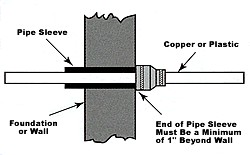As temperatures plummet, homeowners often face the chilling prospect of frozen pipes. When water freezes, it expands, and this expansion can exert tremendous pressure on pipes, potentially leading to cracks, bursts, and costly water damage. Understanding how to prevent your pipes from freezing is crucial to safeguarding your home and avoiding expensive repairs. This guide provides essential steps to protect your plumbing system during cold weather and what to do if your pipes do freeze.
Understanding the Risks of Frozen Pipes
Frozen pipes are more than just an inconvenience; they can cause significant damage to your property. When water inside pipes freezes and expands, it can crack or burst the pipe material, whether it’s copper, PVC, or steel. This damage often occurs where the pressure is greatest – not necessarily where the ice blockage forms. A burst pipe can release hundreds of gallons of water, leading to flooding, structural damage, mold growth, and extensive repair bills. Pipes located in unheated areas like basements, attics, crawl spaces, and exterior walls are particularly vulnerable to freezing temperatures.
Proactive Steps to Prevent Frozen Pipes
Prevention is always better than cure, and taking proactive steps before and during cold weather can significantly reduce the risk of frozen pipes. Here are key preventative measures:
Maintain Consistent Heat
One of the simplest yet most effective ways to prevent pipes from freezing is to maintain a consistent temperature inside your home. Set your thermostat to at least 55°F (13°C) even when you are away. This ensures that the temperature inside your house remains above freezing, reducing the risk of pipes in exterior walls or poorly insulated areas from getting too cold. Don’t lower the thermostat at night, as this can increase the risk of freezing, especially overnight when temperatures typically drop further.
Drip Faucets
Allowing a slight drip from faucets, particularly those furthest from your main water valve, can prevent pipes from freezing. Moving water, even a trickle, is less likely to freeze than stagnant water. This is especially important for pipes that run through unheated or poorly insulated areas. Choose a faucet that is on an outside wall if possible.
Insulate Pipes
Exposed pipes in unheated areas are prime candidates for freezing. Insulating these pipes can make a significant difference. Use pipe sleeves, heat tape, or fiberglass wrap to insulate pipes in basements, attics, crawl spaces, and garages. Pay special attention to pipes near exterior walls or in areas prone to drafts.
 pipe sleeve
pipe sleeve
A pipe sleeve installed on a copper water pipe for insulation, a preventative measure against freezing temperatures.
Open Cabinets
During periods of extreme cold, open kitchen and bathroom cabinet doors, especially those on exterior walls. This allows warmer air to circulate around the plumbing and helps prevent pipes under sinks and along exterior walls from freezing. Make sure to remove any harmful cleaners or chemicals if you have children or pets.
Manage Outdoor Spigots
Outdoor faucets and spigots are highly susceptible to freezing. Before winter arrives, disconnect and drain garden hoses. Turn off the water supply to outside spigots from inside your house. After shutting off the inside valve, open the outside spigot to allow any remaining water in the pipe to drain out. Leaving the outside spigot slightly open throughout the winter can also help relieve pressure if any residual water freezes and expands.
Winterize Irrigation Systems
If you have a lawn irrigation system, it’s crucial to winterize it properly to prevent frozen pipes and damage to the system. Follow the manufacturer’s instructions to drain water from the system. This usually involves shutting off the water supply, opening valves to drain the lines, and using compressed air to blow out any remaining water in the pipes and sprinkler heads.
What to Do If Your Pipes Freeze
Even with preventative measures, pipes can still freeze during extreme cold snaps. Knowing how to handle frozen pipes can minimize damage.
Identify a Frozen Pipe
If you turn on a faucet and only a trickle or no water comes out, it could be a sign of frozen pipes. Other signs include visible frost on pipes or bulging pipes. Check all faucets in your house to see if the problem is isolated or widespread. It’s also a good idea to check with neighbors to see if they are experiencing similar issues, which could indicate a problem with the main water line.
Thawing Frozen Pipes Safely
If you suspect a frozen pipe, act quickly but safely. First, turn off the main water supply to your house to minimize damage if a pipe bursts during thawing. Then, open the faucet served by the frozen pipe. As you thaw the pipe, the melting ice will need somewhere to go, and opening the faucet relieves pressure in the system and allows water to flow out once thawing begins.
Apply heat to the frozen section of the pipe. You can use a hairdryer, electric heat tape, or a portable space heater. Start heating the pipe closest to the faucet and work your way towards the colder section. Never use an open flame device like a propane torch, kerosene or propane heater, as these can overheat the pipes and pose a fire hazard. Avoid pouring boiling water directly onto pipes as the rapid temperature change can cause them to crack.
When to Call a Plumber
If you cannot locate the frozen section of pipe, cannot access it easily, or are unable to thaw it yourself, call a licensed plumber immediately. Also, if you suspect a pipe has already burst or if you have leaks after thawing, it’s essential to seek professional help. Plumbers have the expertise and tools to safely thaw frozen pipes and repair any damage.
Locating Your Main Water Shut-Off Valve
In an emergency, like a burst pipe, knowing how to quickly shut off your main water supply is critical. Familiarize yourself with the location of your main water shut-off valve. It is usually located where the water line enters your house, often in the basement, crawl space, or garage, facing the street. In warmer climates, it may be in a box outside your home, near the water meter. Once located, ensure you can operate the valve. Marking the valve with bright tape can make it easier to find in a hurry, especially in low-light conditions.
Conclusion
Preventing frozen pipes is a vital part of home maintenance in cold climates. By taking proactive steps like maintaining consistent heat, insulating pipes, and managing outdoor spigots, you can significantly reduce the risk of frozen pipes and the potential for costly damage. Being prepared and knowing what to do if pipes do freeze can save you from significant headaches and expenses. Take action now to protect your home’s plumbing system this winter.
